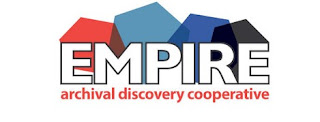By Rachel Dworkin
We recently joined EmpireADC, or the Empire Archival Discovery Cooperative. EmpireADC is run by the New York State Library Network, which provides technical services to libraries and archives across the state. In the early 2000s, NYSLN surveyed archivists from across New York (me included) and found that what we all really wanted was a site that could bring together finding aids from New York’s vast and varied archival, historical, and special collections to make them more discoverable by researchers. After years of planning and coding, EmpireADC was created to be that site! It currently hosts finding aids from over 75 institutions, large and small, and it’s growing all the time.
The platform is pretty neat. It is searchable by keyword, subject, or surname. Researchers can narrow their results by institution, or they can see what’s available on a topic across the entire state. For example, if I were researching the history of the NAACP in New York State, I would see that not only does the Chemung County Historical Society have the records of the Elmira-Corning Branch, the State University of New York at Albany has the records of the Albany and Schenectady branches, and Syracuse University has the records of the Syracuse branch. Being on EmpireADC will hopefully help people who’ve never even heard of our institution before become aware of all we have to offer.
EmpireADC offers a lot of benefits to a small repository like us. For a one-time fee of $50, we get a place to share our finding aids that we don’t have to maintain. We also get skilled tech support for assistance with uploading and maintaining the finding aids. And that’s on top of the free advertising we get just from being on the site!
In the month-and-a-half we’ve been members, I have uploaded at least one finding aid a day. A finding aid is an index for an archival collection which provides additional context about the creator(s) of the collection and the circumstances under which the collection was created, as well as the collection’s size and organization. As of this past Friday, 46 finding aids are live. Only 265 to go! Unfortunately, there’s a bit of work to convert our old finding aids into the format required by EmpireADC. Still, by this time next year I hope to have all our old collections posted and get started sharing the finding aids for our newest acquisitions. If you like data entry, please consider volunteering to help with the process. Check out our current finding aids here: https://www.empireadc.org/search/repositories/nelmhi
Some of my favorite recently uploaded finding aids include the Ganung Real Estate Collection, the United Baptist Church Collection, and the Philip Burnham Research Papers.
The Ganung Real Estate Collection contains photographs, listing details, and other documents associated with properties sold by the Ganung Realty Company from 1936-1960. It is a veritable gold mine for anyone searching the history of their home. (https://www.empireadc.org/search/catalog/nelmhi_5304)
The United Baptist Church Collection contains the combined records of the First Baptist Church and Southside Baptist Church of Elmira. This includes membership records dating back to the 1820s, making it a valuable resource for genealogists. (https://www.empireadc.org/search/catalog/nelmhi_5241)
The Philip Burnham Research Papers contain Mr. Burnham’s research notes and source material for his book So Far From Dixie about the Elmira Prison Camp. This is actually one of our newest collections. (https://www.empireadc.org/search/catalog/nelmhi_5246)





